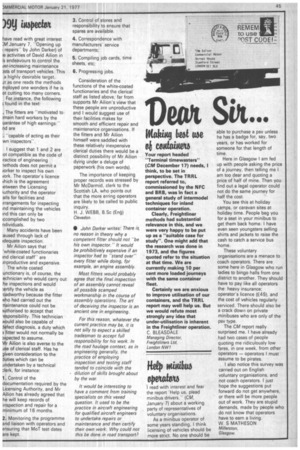) 9 U ho ped:ft
Page 47

If you've noticed an error in this article please click here to report it so we can fix it.
have read with great interest :M January 7, "Opening up repairs" by John Darker) of le activities of David Ailion in endeavours to control the wer-increasing maintenance )sts of transport vehicles. This a highly desirable target, it as one reads the methods rnployed one wonders if he is ot cutting too many corners.
For instance, the following ; found in the text:
. The fitters are -motivated to main hard workers by the uarantee of high earnings:" nd are
"capable of acting as their wn inspectors".
I suggest that 1 and 2 are at compatible as the code of ractice of engineering lethods does not permit a worker to inspect his own work. The operator's licence which is the agreement ietween the Licensing kuthority and the operator :alls for facilities and irrangements for inspecting ind maintaining the vehicles Ind this can only be iccomplished by two ndividuals.
Many accidents have been :aused through lack of idequate inspection.
Mr Ailion says that 'white-coated functionaries ind clerical staff' are rnproductive and expensive.
The white coated unctionary is, of course, the echnician who would carry out he inspections and would ;ertify the vehicle as
• oadworthy because the fitter vho had carried out the naintenance could not be wthorised to accept that -esponsibility. This technician would also be capable of lefect diagnosis, a duty which 3 fitter would not normally be axpected to assume.
Mr Ailion is also averse to the Jse of clerical staff. Has he given consideration to the Julies which can be indertaken by a technical ;Jerk, for instance: 1. Control of the documentation required by the Licensing Authority, and Mr Ailion has already agreed that he will keep records of inspection and repair for a minimum of 16 months.
2. Monitoring the programme and liaison with operators and ensuring that MoT test dates are kept. 3. Control of stores and responsibility to ensure that spares are available.
4. Correspondence with manufacturers' service departments; 5. Compiling job cards, time sheets, etc; 6. Progressing jobs.
Consideration of the functions of the white-coated functionaries and the clerical staff as listed above, far from supports Mr Ailion's view that these people are unproductive and I would suggest use of their facilities makes for smooth and efficient repair and maintenance organisations If the fitters and Mr Ailion himself were saddled with these relatively inexpensive clerical duties there would be a distinct possibility of Mr Ailion dying under a deluge of paperwork (his own words).
The importance of keeping proper records was stressed by Mr McDarmid, clerk to the Scottish LA, who points out that the more erring operators are likely to be called to public inquiry.
H. J. WEBB, B.Sc (En) Clevedon.
• John Darker writes: There is no reason in theory why a competent fitter should not "be his own inspector." It would be prohibitively expensive if an inspector had to "stand over" every fitter while doing, for example, an engine assembly.
Most fitters would probably agree that the final inspection of an assembly cannot reveal all possible scamped workmanship in the course of assembly operations. The art of deceiving the inspector is an ancient one in engineering.
For this reason, whatever the current practice may be, it is not silly to expect a skilled tradesman to accept full responsibility for his work. In the road haulage context, as in engineering generally, the practice of employing inspection and testing staff tended to coincide with the dilution of skills brought about by the war.
It would be interesting to have a comment from training specialists on this vexed question. It used to be the practice in aircraft engineering for qualified aircraft engineers to undertake repairs or maintenance and then certify their own work. Why could not this be done in road transport?


























































































































